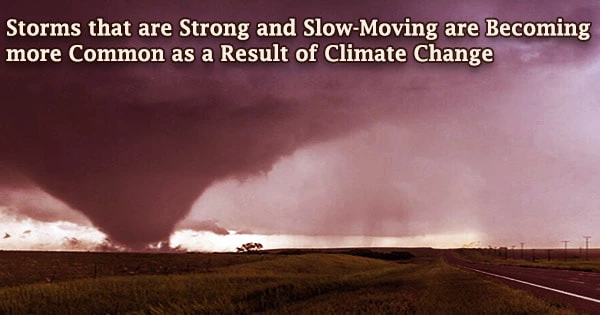According to a recent study by Newcastle University and the Met Office, climate change is causing a significant rise in powerful, slow-moving storms. Climate specialists have discovered that the incidence of slow-moving strong rainstorms would rise significantly in the future, based on their research into how climate impacts violent rainstorms across Europe.
The average weather in a location over a long period of time is referred to as climate. Climate change is the result of a change in the average circumstances. Humans’ use of oil, gas, and coal for their houses, industry, and transportation is causing fast climate change. When fossil fuels are burned, they produce greenhouse gases, mostly carbon dioxide (CO2). The heat from the Sun is trapped by these gases, causing the planet’s temperature to rise.
By the end of the century, experts predict that these slow-moving storms would be 14 times more common throughout land. As we witnessed in Germany and Belgium, these slow-moving storms have the potential for very significant precipitation accumulations, with disastrous consequences.
The researchers conducted extremely sophisticated climate model simulations at the UK Met Office Hadley Centre, coordinated by Dr Abdullah Kahraman of Newcastle University’s School of Engineering. They discovered that slower storm movement increases the quantity of rain that collects locally, raising the danger of flash floods across Europe beyond what prior research predicted.
The findings of the study, which were published in the journal Geophysical Research Letters, demonstrate that as climate change progresses, storms that produce severe rain may move slower, extending the duration of exposure to these extremes.
Dr Abdullah Kahraman, who is also a visiting scientist at the Met Office, said:
“With recent advances in supercomputer power, we now have pan-European climate simulations resolving the atmosphere in high detail as short-range weather forecasting models do. These models have grid spacing of approximately 2 km, which allows them to simulate storm systems much better, resulting in better representation of extremes.”
“We created metrics to identify prospective scenarios for heavy rainfall, as well as a smaller, almost-stationary subset of these events with the potential for large rainfall accumulations, using these cutting-edge climate models. These measures provide us a comprehensive picture of the situation and help us figure out which atmospheric elements lead to severe rainfall variations.”
“This is one of the first studies to explore changes in the speed of such heavy rainfall systems an important aspect contributing to flood risk. Currently, we are also investigating other extreme weather types by examining the climate simulations data with a severe weather forecaster’s perspective.”
Professor Hayley Fowler, of Newcastle University’s School of Engineering, added: “Governments all across the globe have been too sluggish to reduce greenhouse gas emissions, resulting in continued global warming. According to this analysis, extreme storm changes will be considerable, resulting in an increase in the frequency of disastrous floods across Europe. This, alongside the current floods in Europe, is the wake-up call we need to produce improved emergency warning and management systems, as well as implementing climate change safety factors into our infrastructure designs to make them more robust to these severe weather events.”
Professor Lizzie Kendon, Science Fellow at the Met Office and Professor at Bristol University, said: “This study shows that in addition to the intensification of rainfall with global warming, we can also expect a big increase in slow-moving storms which have the potential for high rainfall accumulations. This is particularly pertinent in light of the recent floods in Germany and Belgium, which has highlighted the destructive effects of slow-moving storms.”
“Our finding that slow-moving intense rainstorms could be 14 times more frequent by the end of the century under the high emissions RCP8.5 scenario, shows the serious impacts that we may expect across Europe if we do not curb our emissions of greenhouse gases.”
The conclusions of the study are important to European climate mitigation and adaptation strategy, with specific implications for future flooding impacts, infrastructure design, and water resource management.
Emissions are continuing to grow. As a result, the Earth is currently 1.1 degrees Celsius warmer than it was in the late 1800s, with the previous decade (2011-2020) being the hottest on record. People in impoverished nations would bear the brunt of the consequences because they lack the financial means to adapt to climate change. Many farmers in poor nations already have to deal with excessively hot temperatures, and things are only going to grow worse.
Currently, nearly stationary heavy rainstorms are unusual in Europe, and they only occur seldom over portions of the Mediterranean Sea. Accurate forecasts of future changes in extreme rainfall events are essential for developing effective adaptation and mitigation strategies to mitigate the negative effects of climate change.
















